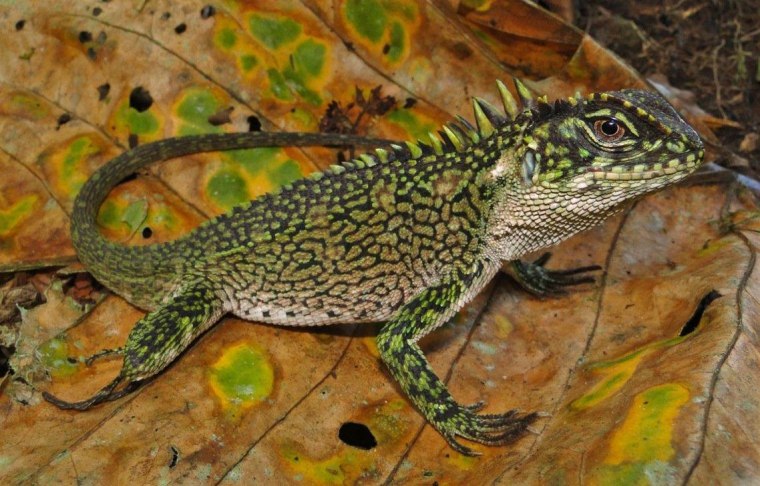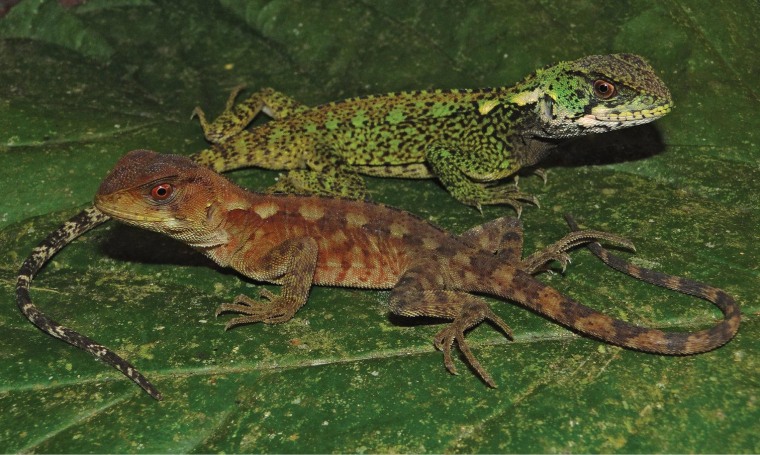
Scientists say they're intrigued by two new species of woodlizards found in the Peruvian jungle, and not just because of their scary-cool looks.
The lizards, described in the open-access journal Zookeys, were found in Cordillera Azul National Park, which was created to protect Peru's largest mountain rainforest. The area includes some of the country's least-explored forests.
The males of both species sport distinctive patterns of green spots on a brown and black background. One species, Enyalioides azulae, is known only from a single locality in the mountain rainforest of northeastern Peru's Rio Huallaga basin. The other, E. binzayedi, lives in the same river basin. "Azulae" refers to Cordillera Azul National Park, while "binzayedi" pays tribute to the sponsor of the discoverers' field survey, Sheikh Mohamed bin Zayed Al Nahyan, crown prince of Abu Dhabi and the creator of a conservation fund bearing his name.
These two species take their place alongside 10 others in the genus Enyalioides. Three of those 10 were discovered just in the past five years, and the researchers say that suggests that "more species might be awaiting discovery in other unexplored areas close to the Andes."
"Thanks to these discoveries, Peru becomes the country holding the greatest diversity of woodlizards," lead author Pablo Venegas of Peru's Center for Ornithology and Biodiversity, or CORBIDI, said in a news release from Pensoft Publishers. "Cordillera Azul National Park is a genuine treasure for Peru, and it must be treated as a precious future source of biodiversity exploration and preservation!"
The two species apparently share the same territory, with only a slight difference in altitude ranges. That's what's intriguing: The researchers say the lizards' differences, as reflected in their mitochondrial DNA as well as body characteristics, may reflect the subtle effects of evolutionary divergence.

More species worth marveling at:
- Borneo bio-hunt turns up treasures
- Strange species found in Suriname
- Taking stock of 2011's new species
- New bee or not new bee? That is the question
- 'Lost' rainbow toad rediscovered
- Froggy finds raise hopes for Haiti
- Three new frogs leap into spotlight
- Amphibians wanted ... alive
- The Amazon's amazing species
- Biological gems found in Philippines
- Madagascar offers hundreds of new species
- Scientists spot biological beauties in Bali
- RAP stars rock the animal world
- Scientists finish first sea census
- Deep-sea creatures of the Coral Sea
- The top 10 new species from 2010
- Beautiful biodiversity in Brazil
- New Guinea's 'Lost World' revisited
- Indonesia's 'Garden of Eden'
- Papua New Guinea's new species
- Marine marvels from Papua New Guinea
- Biological treasures from Borneo
- Celebrities of the Celebes Sea
- 12 froggy finds from India
- Fantastic frogs from Colombia
- Aliens lurk in Antarctic depths
- More strange species from Suriname
- Vulnerable new species in Brazil
- Discoveries from Vietnam's 'Green Corridor'
- Endangered species of the Mekong Delta
- New species from Australia's coral reefs
- Thousands of new species in ocean's depths
- Hundreds of new species amid the Himalayas
- New species found Down Under ... underground
For more about the Peruvian woodlizards, check out Nadia Drake's report for Wired.
Alan Boyle is NBCNews.com's science editor. Connect with the Cosmic Log community by "liking" the log's Facebook page, following @b0yle on Twitter and adding the Cosmic Log page to your Google+ presence. To keep up with Cosmic Log as well as NBCNews.com's other stories about science and space, sign up for the Tech & Science newsletter, delivered to your email in-box every weekday. You can also check out "The Case for Pluto," my book about the controversial dwarf planet and the search for new worlds.